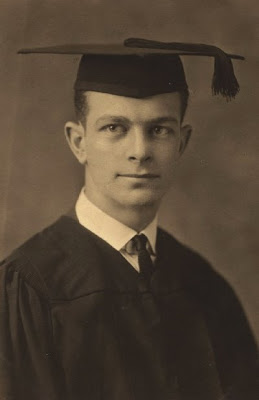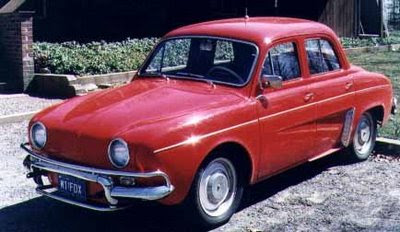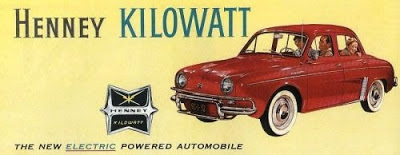Philosophy
 Linus Carl Pauling
Linus Carl Pauling
February 28th, 1901 to August 19th, 1994
 Henney Kilowatt
Henney Kilowatt
1959

I am sure that most are familiar with Linus Pauling for several major features: His innovative research regarding chemical bonding [quantum chemistry], his participation in the "double helix" research [suggesting a helical structure for deoxyribonucleic acid (DNA)], his activity with Einstein, Bertrand Russell and eight others to sign the Russell-Einstein Manifesto in 1955 [nuclear weapon constraints], and his promotion of Vitamin C. But he was also involved in the electric automobile--the Henney Kilowatt.
In the late 1950s, Pauling became concerned with the problem of air pollution—particularly with the growing smog problem in Los Angeles. At the time, most scientists believed that the smog was due to chemical plants and refineries, not gasoline engine exhaust. Pauling worked with Arie Haagen-Smit and others at Caltech to show that smog was a product of automobile pollution instead of factory pollution. Shortly after this discovery, Pauling began work to develop a practical and affordable electric car. He joined forces with the engineers at the Eureka Williams company in the development of the Henney Kilowatt—the first speed-controlled electric car. After researching the electrophysics underlying the initial Kilowatt propulsion system, Pauling determined that traditional lead-acid batteries would not provide the power necessary to give electric cars the performance necessary to rival traditional gasoline powered cars. Pauling accurately predicted that the low top speed and the short range of the Henney Kilowatt would make them impractical and unpopular. Pauling insisted on making the car more practical before releasing it to the public, and recommended that the project be discontinued until the appropriate battery was available commercially. Unfortunately, the Eureka Williams Company insisted that production plans for the car proceed; as Pauling predicted, the model experienced dismal sales.--Wikopedia.
And:
Henney Kilowatt was the world's first transistor-regulated electric car. It was a project of National Union Electric Company and Henney Motor Company, a coachbuilder known especially for their conversions of Packards to ambulances, hearses and limousines. The tooling and parts for the car were purchased from Renault, therefore the car looks virtually identical to Renault Dauphine. The electric propulsion system was designed and built by Eureka Williams, manufacturer of vacuum cleaners.
Production started in 1959, initially with a 36-volt system of two sequential 18-volt batteries. This solution was soon deemed impractical as the car had a range of only 40 miles and top speed of around 40 mph. For the 1960 model year Henney was fitted with a 72-volt system consisting of six 12-volt batteries. This allowed the car to reach 60 mph and drive over 60 miles on a single charge.
During the two-year production run, 100 rolling chassis were produced, of which only 47 were completed as functional cars and sold. 32-35 cars were sold to electric utility companies and only 12-15 to general public. The company continued to promote the Kilowatt in 1961 in hope of finishing and selling the remaining 53 chassis, but only a few cars were sold. The main problem was that the 72-volt system was too expensive and complicated to attain the targeted $3600 tag price.
It is estimated that between 4 and 8 cars still exist.Among them are the very first two cars - the prototype and the s/n 0001 - which for 45 years had been stored by a former company engineer, and a few years ago sold with less than 500 miles driven.
- Lancia Megagamma [1978-1978]: Strange Things Sometimes Become Useful
Lancia Megagamma Nucleon Maybe there is some truth in "what goes around, comes around" and bizarre things become practical. As for Ford's "Nucleon"...well, I remember my 5th grade teacher [yes, the Eisenhower era and dreams of everything atomic] claiming...
- The Toy Train Man...joshua Lionel Cowen
Joshua Lionel Cowen August 25th, 1880 to September 8th, 1965 Joshua Lionel Cowen was an "American inventor of electric model trains who founded the Lionel Corporation (1901), which became the largest U.S. toy train manufacturer. At age 18, he had invented...
- Joyce Myron...what Happened To Her?
Joyce Myron photographed in front of the California atomic-electric power plant being built by Pacific Gas & Electric Company and General Electric. With her are some of the men who operate the plant and the G-E Vallecitos Atomic Laboratory, site...
- Deceased--geoff Ballard
Geoff Ballard October 16th, 1932 to August 2nd, 2008 Perhaps in time his name and association with fuel cells will be more popular. "Geoff Ballard, 75; geophysicist expanded use of fuel cells" by Thomas H. Maugh II August 11th, 2008 Los Angeles Times...
- "carrot And Stick"...for Energy Alternatives?
The "carrot and stick" methodology has often served global commerce good...money rules. "McCain offers prize for cutting-edge battery" In Fresno, he says he would award $300 million to whoever developed a new device that could efficiently power cars....
Philosophy
Henney Kilowatt--Linus Pauling
 Linus Carl Pauling
Linus Carl Pauling February 28th, 1901 to August 19th, 1994
 Henney Kilowatt
Henney Kilowatt1959

I am sure that most are familiar with Linus Pauling for several major features: His innovative research regarding chemical bonding [quantum chemistry], his participation in the "double helix" research [suggesting a helical structure for deoxyribonucleic acid (DNA)], his activity with Einstein, Bertrand Russell and eight others to sign the Russell-Einstein Manifesto in 1955 [nuclear weapon constraints], and his promotion of Vitamin C. But he was also involved in the electric automobile--the Henney Kilowatt.
In the late 1950s, Pauling became concerned with the problem of air pollution—particularly with the growing smog problem in Los Angeles. At the time, most scientists believed that the smog was due to chemical plants and refineries, not gasoline engine exhaust. Pauling worked with Arie Haagen-Smit and others at Caltech to show that smog was a product of automobile pollution instead of factory pollution. Shortly after this discovery, Pauling began work to develop a practical and affordable electric car. He joined forces with the engineers at the Eureka Williams company in the development of the Henney Kilowatt—the first speed-controlled electric car. After researching the electrophysics underlying the initial Kilowatt propulsion system, Pauling determined that traditional lead-acid batteries would not provide the power necessary to give electric cars the performance necessary to rival traditional gasoline powered cars. Pauling accurately predicted that the low top speed and the short range of the Henney Kilowatt would make them impractical and unpopular. Pauling insisted on making the car more practical before releasing it to the public, and recommended that the project be discontinued until the appropriate battery was available commercially. Unfortunately, the Eureka Williams Company insisted that production plans for the car proceed; as Pauling predicted, the model experienced dismal sales.--Wikopedia.
And:
Henney Kilowatt was the world's first transistor-regulated electric car. It was a project of National Union Electric Company and Henney Motor Company, a coachbuilder known especially for their conversions of Packards to ambulances, hearses and limousines. The tooling and parts for the car were purchased from Renault, therefore the car looks virtually identical to Renault Dauphine. The electric propulsion system was designed and built by Eureka Williams, manufacturer of vacuum cleaners.
Production started in 1959, initially with a 36-volt system of two sequential 18-volt batteries. This solution was soon deemed impractical as the car had a range of only 40 miles and top speed of around 40 mph. For the 1960 model year Henney was fitted with a 72-volt system consisting of six 12-volt batteries. This allowed the car to reach 60 mph and drive over 60 miles on a single charge.
During the two-year production run, 100 rolling chassis were produced, of which only 47 were completed as functional cars and sold. 32-35 cars were sold to electric utility companies and only 12-15 to general public. The company continued to promote the Kilowatt in 1961 in hope of finishing and selling the remaining 53 chassis, but only a few cars were sold. The main problem was that the 72-volt system was too expensive and complicated to attain the targeted $3600 tag price.
It is estimated that between 4 and 8 cars still exist.Among them are the very first two cars - the prototype and the s/n 0001 - which for 45 years had been stored by a former company engineer, and a few years ago sold with less than 500 miles driven.
- Lancia Megagamma [1978-1978]: Strange Things Sometimes Become Useful
Lancia Megagamma Nucleon Maybe there is some truth in "what goes around, comes around" and bizarre things become practical. As for Ford's "Nucleon"...well, I remember my 5th grade teacher [yes, the Eisenhower era and dreams of everything atomic] claiming...
- The Toy Train Man...joshua Lionel Cowen
Joshua Lionel Cowen August 25th, 1880 to September 8th, 1965 Joshua Lionel Cowen was an "American inventor of electric model trains who founded the Lionel Corporation (1901), which became the largest U.S. toy train manufacturer. At age 18, he had invented...
- Joyce Myron...what Happened To Her?
Joyce Myron photographed in front of the California atomic-electric power plant being built by Pacific Gas & Electric Company and General Electric. With her are some of the men who operate the plant and the G-E Vallecitos Atomic Laboratory, site...
- Deceased--geoff Ballard
Geoff Ballard October 16th, 1932 to August 2nd, 2008 Perhaps in time his name and association with fuel cells will be more popular. "Geoff Ballard, 75; geophysicist expanded use of fuel cells" by Thomas H. Maugh II August 11th, 2008 Los Angeles Times...
- "carrot And Stick"...for Energy Alternatives?
The "carrot and stick" methodology has often served global commerce good...money rules. "McCain offers prize for cutting-edge battery" In Fresno, he says he would award $300 million to whoever developed a new device that could efficiently power cars....
